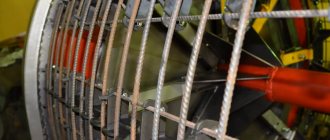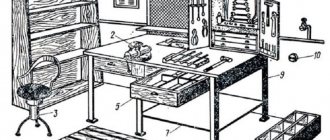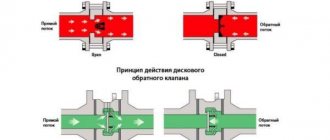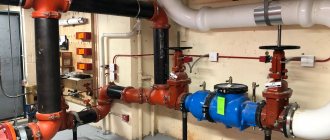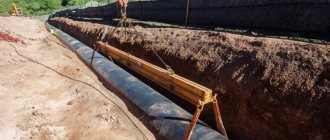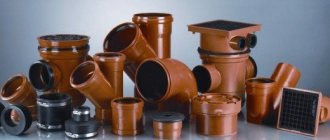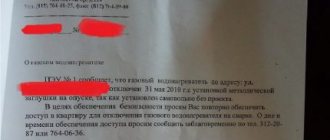The normal pressure in any piping or tank system is important to monitor. This is what a pressure gauge is needed for. This control device displays the actual pressure in the process system. Pressure gauges have different sensing elements, the main ones being a capsule spring (for measuring low pressure) and a tubular spring (for measuring high pressure). Also, when selecting, it is worth considering that they are designed for different working media (gaseous, liquid, etc.). For example, the requirements for selecting and installing a pressure gauge on a pipeline with cold water and superheated steam will differ significantly.
Legislative framework of the Russian Federation
Free legal aid hotline
Navigation
Federal legislation
Actions
- home
- “RULES FOR THE CONSTRUCTION AND SAFE OPERATION OF PRESSURE VESSELS. PB 10-115-96" (approved by Resolution of the State Mining and Technical Supervision of the Russian Federation dated 04/18/95 N 20) (as amended on 09/02/97)
| Name of document | “RULES FOR THE CONSTRUCTION AND SAFE OPERATION OF PRESSURE VESSELS. PB 10-115-96" (approved by Resolution of the State Mining and Technical Supervision of the Russian Federation dated 04/18/95 N 20) (as amended on 09/02/97) |
| Document type | resolution, list, rules |
| Receiving authority | Gosgortekhnadzor of the Russian Federation |
| Document Number | 20 |
| Acceptance date | 01.01.1970 |
| Revision date | 02.09.1997 |
| Date of registration with the Ministry of Justice | 01.01.1970 |
| Status | cancelled/lost force |
| Publication |
|
| Navigator | Notes |
5.3.1. Each vessel and independent cavities with different pressures must be equipped with direct-acting pressure gauges. The pressure gauge is installed on the vessel fitting or pipeline between the vessel and the shut-off valve.
5.3.2. Pressure gauges must have an accuracy class of at least: 2.5 - at a vessel operating pressure of up to 2.5 MPa (25 kgf/sq. cm), 1.5 - at a vessel operating pressure above 2.5 MPa (25 kgf/sq. cm ).
5.3.3. The pressure gauge must be selected with a scale such that the limit for measuring working pressure is in the second third of the scale.
5.3.4. The owner of the vessel must mark the pressure gauge scale with a red line indicating the operating pressure in the vessel. Instead of the red line, it is allowed to attach a metal plate painted red to the pressure gauge body and tightly adjacent to the glass of the pressure gauge.
5.3.5. The pressure gauge must be installed so that its readings are clearly visible to operating personnel.
5.3.6. The nominal diameter of the body of pressure gauges installed at a height of up to 2 m from the level of the observation platform must be at least 100 mm, at a height of 2 to 3 m - at least 160 mm.
Installation of pressure gauges at a height of more than 3 m from the site level is not permitted.
5.3.7. A three-way valve or a device replacing it must be installed between the pressure gauge and the vessel, allowing periodic checking of the pressure gauge using a control valve.
In necessary cases, the pressure gauge, depending on the operating conditions and the properties of the medium in the vessel, must be equipped with either a siphon tube, or an oil buffer, or other devices that protect it from direct exposure to the medium and temperature and ensure its reliable operation.
5.3.8. On vessels operating under pressure above 2.5 MPa (25 kgf/sq. cm) or at ambient temperatures above 250 degrees. C, as well as with an explosive atmosphere or harmful substances of hazard classes 1 and 2 according to GOST 12.1.007, instead of a three-way valve, it is allowed to install a separate fitting with a shut-off device for connecting a second pressure gauge.
On stationary vessels, if it is possible to check the pressure gauge within the time limits established by these Rules by removing it from the vessel, the installation of a three-way valve or a device replacing it is not necessary.
On mobile vessels, the need to install a three-way valve is determined by the vessel design developer.
5.3.9. Pressure gauges and pipelines connecting them to the vessel must be protected from freezing.
5.3.10. The pressure gauge is not allowed for use in cases where:
there is no seal or stamp indicating verification;
when it is turned off, the arrow does not return to the zero scale reading by an amount exceeding half the permissible error for this device;
the glass is broken or there is damage that may affect the accuracy of its readings.
5.3.11. Checking of pressure gauges with their sealing or branding must be carried out at least once every 12 months. In addition, at least once every 6 months, the owner of the vessel must carry out an additional check of the working pressure gauges with a control pressure gauge and record the results in the control check log. In the absence of a control pressure gauge, it is allowed to carry out an additional check with a proven working pressure gauge that has the same scale and accuracy class as the pressure gauge being tested.
The procedure and timing for checking the serviceability of pressure gauges by maintenance personnel during the operation of vessels should be determined by the Instructions for the operation mode and safe maintenance of vessels, approved by the management of the organization that owns the vessel.
Instructions for servicing technical pressure gauges General provisions
The liquid level in the separation vessel, the horizontal pressure supply to the complex being verified and the lower plane of the measuring column fitting must be in the same horizontal plane. If this condition is not met, the measurement result must take into account the influence of the hydrostatic liquid column.
Depending on the functional purpose of the pressure gauges, it is possible to highlight individual elements of the scale in bright colors (green, yellow, red).
First, let's look at the requirements for pressure gauges according to GOST:
- Installation of the device in accordance with GOST can be carried out on the vessel fitting up to the shut-off valves.
- The main requirement according to GOST, which must be presented, concerns such a nuance as the error of the pressure gauge. The accuracy class must be at least 2.5 if the operating pressure level is below 25 kg/cm2. If the pressure is higher, then the accuracy class should be equal to 1.5.
- Any device according to GOST is equipped with a scale so that the measurement limit of the required parameter is located in the second third of the scale.
After the device is installed and the system is ready for operation in normal mode, then to ensure the safety of the device, it is not advisable to immediately load the installed measuring equipment. It is advisable to increase the pressure gradually, without any jumps and without crossing the established boundaries.
Frequency of checking pressure gauges
A pressure gauge is a device that measures pressure in a device, container, or pipeline. There are several types:
- spiral;
- membrane
Spiral pressure gauges consist of a metal spiral that is connected by a transmitting element connected to a pointer on a dial. The higher the pressure, the more the spiral unwinds and pulls the arrow along with it. Which is reflected in an increase in pressure readings on the instrument scale.
The diaphragm pressure gauge provides readings due to a clamped flat plate, which is connected to the transmitting element. When exposed to pressure, the membrane bends and the transmitting element presses on the dial arrow. This is how blood pressure increases.
To check the compliance of the accuracy parameters of the meter declared by the manufacturer and to monitor the metrological serviceability of the device, without which the pressure gauge cannot be used in areas falling under GROEI (state regulation for ensuring the uniformity of measurements), and also to ensure that the device serves the established period and operation is safe, it should be periodically carried out checking the pressure gauge. The rules set by the state state that, depending on the technical characteristics of the device and the manufacturer's instructions, the reconciliation period ranges from 12 months to 5 years.
Regular inspection of the device after a year was considered the most common, but now manufacturers are improving the characteristics of the equipment, and devices with a verification period of 2 years are increasingly found. It is worth remembering that the pressure gauge must undergo inspection and verification after a certain period from the date of production, and not from the moment it is put into operation.
Purpose and scope
Whereas the starting point must be taken - a month from production. Now there are also pressure gauges that can be verified once every 2 years. GOST R 8.905-2015 State system for ensuring the uniformity of measurements (GSI). Indicating pressure gauges. Working measuring instruments.
There is a lot of useful information in the book. We worked hard to write it and deserve a small reward

